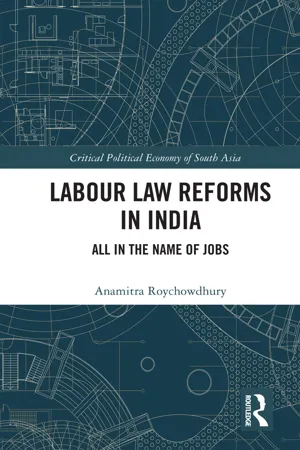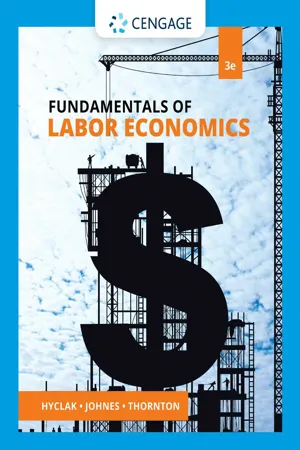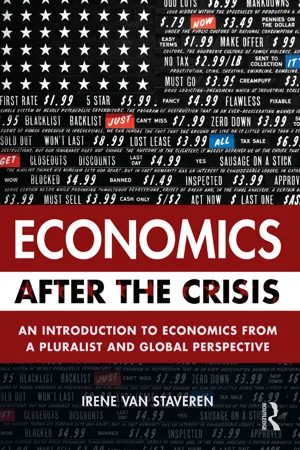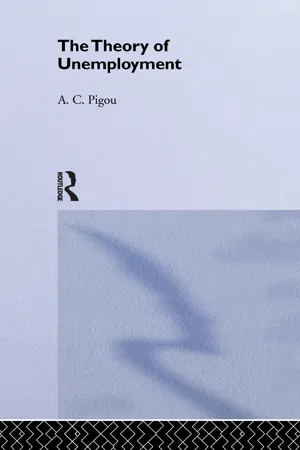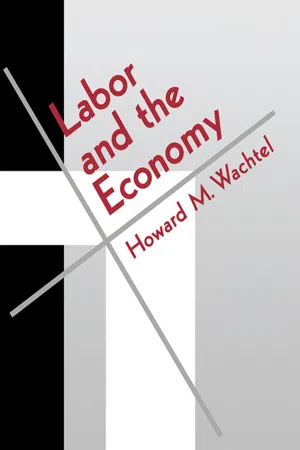Economics
Demand for Labour
The demand for labor refers to the quantity of labor that employers are willing and able to hire at a given wage rate. It is influenced by factors such as the productivity of labor, the price of the goods or services being produced, and the availability of alternative inputs. As the demand for goods and services in the economy increases, the demand for labor also tends to rise.
Written by Perlego with AI-assistance
Related key terms
1 of 5
9 Key excerpts on "Demand for Labour"
- eBook - ePub
- Stephen W. Smith(Author)
- 2003(Publication Date)
- Routledge(Publisher)
2 Labour demand and productivity INTRODUCTIONEssentially the Demand for Labour is a derived demand because no firm demands labour for its own sake. Labour is one of the factors of production which firms combine and organise in order to generate output. Consumers demand goods and services which producers seek to supply profitably. Hence they demand labour to help produce goods and services to meet the requirements of consumers. To illustrate the derived nature of labour demand consider the case where a firm expects demand for its products to increase due to greater personal disposable incomes arising from tax cuts. In such circumstances if the extra supply to meet the rising demand is commensurate with the firm’s business plans, then one may reasonably expect that the Demand for Labour will increase. Yet whatever the objective of the firm (profit maximisation, growth, market share, etc.) the decision to employ workers will entail a comparison of the costs and benefits to the firm of doing so. Employing labour gives rise to costs – primarily wages but other costs also exist, national insurance, basic training, etc. The benefit to the firm is mainly the revenue generated by sales of goods/services produced by labour. If the net benefit (total benefit less total cost) is not sufficient then the firm will not employ additional labour or it may lay some workers off. However, it is not necessarily the case that all fluctuations in product demand will result in changes in employment. The firm’s labour demand response to variations in product demand will depend upon the significance and duration of such variations. If a firm is faced with short-run or minor changes in demand for its products then it can counter those fluctuations by adjusting its stocks of unsold goods. Substantial and longer-term changes in demand will induce changes in employment. Productivity is a key ingredient for labour demand so we will analyse the productivity performance of the UK. - eBook - PDF
- L Engelbrecht, A Strydom, L Engelbrecht, A Strydom(Authors)
- 2014(Publication Date)
- Future Managers(Publisher)
Module 2 28 FutureManagers 1.2 Labour demand Labour has a derived demand. This means that there is only a demand for what it is able to produce. This demand comprises employers who require workers to produce goods and services. The demand curve for labour is also a downward sloping curve like the demand for goods and services. Therefore, fewer workers are demanded at lower prices and more at higher prices. The price of labour is the wage rate . The extension in the Demand for Labour results in more workers being employed at lower wages. This could be due to the following reasons: • More workers suddenly available to work entering the labour market. This could be due to high levels of unemployment and a desperation to work or as a result of increases in the size of the population and labour force. • An increase in the skill levels due to improved education can result in more engineers, lawyers or other skilled artisans graduating. As they enter their respective industries, they may find that they command lower wages than before they started studying. It is possible that a contraction in the Demand for Labour can occur. This would result in fewer workers being demanded at a higher wage rate. This could be due to a reduction in the number of workers being available for work. This is the opposite of unemployment. In addition, if education levels drop, shortages of skilled workers would push wages up as employers are forced to pay more for badly needed skills offered by doctors, engineers and artisans. The determinants of labour demand Price of final product As mentioned, labour has a derived demand. Therefore, the price which can be obtained for the good or service that labour produces will determine wage of the workers and the number of workers employed. If a good or service is in low demand, it follows that the Demand for Labour would be lower. By implication, the price of labour (the wage) would be low as well. - eBook - PDF
- Frank Burchill(Author)
- 2017(Publication Date)
- Red Globe Press(Publisher)
If the demand for products grows, other things being equal, employers will demand more of the factors of production. To the extent that capital cannot be substituted or is relatively more expensive, employers will want more labour and THE MARKET FOR LABOUR 15 will offer to pay more for it. Thus, more labour will make itself available and more labour will be employed. If the demand for a particular product grows – for example, computer games – there will be an increase in the demand for those who are capable of programming such games, the pay offered to them will rise and such people will be attracted both from preferring leisure at lower wages and from other occupations. As such when people leave other occupations the pay in those occupations they have left will also rise. As pay levels between occupa-tions are equalised, mobility ceases, having ensured a shift of labour towards the production of computer games. Wages are thus determined by the demand for, and supply of, labour. In this model anyone who wishes to work can approach an employer who uses the type of labour the person can supply and secure work at the current rate or at a rate slightly lower. If the employer has all the workers required at the current rate then an offer to work at a slightly lower rate enables the employer to reduce pay for everybody to that rate and use the savings to employ additional labour. (This result is achieved by the process of offering dismissal to the nearest employee, pointing out that the new one is prepared to work at a lower rate. This employee will probably accept the slight reduction rather than volunteer to leave. If all employees behave in the same way, savings can be made, and labour will become cheaper relative to capital.) It follows that the lower the rate labour is willing to accept, the greater the quantity of labour employed. There will be a rate which would result in everybody being in work. - eBook - ePub
Labour Law Reforms in India
All in the Name of Jobs
- Anamitra Roychowdhury(Author)
- 2018(Publication Date)
- Routledge India(Publisher)
According to the Classical school, the marginal product curve of labour is the labour demand curve, and like typical demand curves, the quantity of labour demand (or employment at the short side of the market) is determined by the independent variable i.e., price of labour (real wage rate). Therefore, in the Classical framework, labour demand is determined by the equation N D = f (real wage). 22 Thus, corresponding to real wage W 1, employment is determined on the labour demand schedule at N 1, and excess labour supply or unemployment is N 2 – N 1. Figure 6.1 Aggregate labour market Now the Classical school explains persistence of unemployment by downward rigidity of real wages. In other words, employment remains arrested at N 1 because trade unions run a ‘closed shop’. Hence, a necessary and sufficient condition for the labour market to clear – according to the Classical theory – is to remove such labour market imperfections (by delegitimising trade union activity or complete removal of hiring and firing costs), which allows the real wage to adjust to W*. Of course, it is granted that workers – in absence of labour market imperfections – would engage in undercutting money -wages and bring down the real wage to the market clearing level, curing unemployment. Let us see what this involves. For simplicity, let us assume that the economy is characterized by a Classical savings function (i.e. all wages are consumed and all profits are saved). Now, for historical reasons, if real wage is W 1, then employment is grounded at N 1. The magnitude of total output is given by the area under the marginal product curve to the left of N 1 by the area, acde. The wage bill is obtained by multiplying the wage rate with the level of employment and is denoted in the figure by bcde. Since national income is distributed between only two categories of income 23 – wages and profits – profits are represented by abc. Now, the nature of capitalist production is commodity production (i.e - eBook - PDF
- Thomas Hyclak, Geraint Johnes, Robert Thornton, , Thomas Hyclak, Thomas Hyclak, Geraint Johnes, Robert Thornton(Authors)
- 2020(Publication Date)
- Cengage Learning EMEA(Publisher)
Due to electronic rights, some third party content may be suppressed from the eBook and/or eChapter(s). Editorial review has deemed that any suppressed content does not materially affect the overall learning experience. Cengage Learning reserves the right to remove additional content at any time if subsequent rights restrictions require it. The Demand for Labor in the Long Run 33 variable? If changes in wage rates occur, employers will be both willing and able to make adjustments in the amounts of labor and other factors that they use. For example: ■ ■ Facing high union wage demands, some employers have chosen to move their operations to a new location (from the northern to the southern United States, from Western to Eastern Europe, from developed to developing countries) where wages are lower or where unionism is less widespread. ■ ■ Given rising wage costs, some employers switch to more capital-intensive methods of production, trying to substitute relatively cheaper capital for relatively more expensive labor. ■ ■ Some labor employment practices in various parts of the world that appear to be inefficient may be perfectly sound when the relative costs of labor and capital are considered. For example, streetcars in some Asian cities have two crew members, a car operator and a fare collector; delivery trucks may have both a driver and one or two delivery boys. Where labor is relatively cheap, it makes sense to produce with a high ratio of labor to capital. To analyze the demand for labor in the long run, let’s return to our production func- tion in terms of capital and labor (see Figure 2.9). And here a new concept is important, the budget constraint. The budget constraint determines how much labor (L) and how much capital (K) a firm can purchase with its current budget. - eBook - ePub
Economics After the Crisis
An Introduction to Economics from a Pluralist and Global Perspective
- Irene van Staveren(Author)
- 2014(Publication Date)
- Routledge(Publisher)
Table 8.6 allows us to determine optimal employment for Roberto’s restaurant, namely where VMPL equals W, or is slightly above it. There is no exact match, but for six students, VMPL comes closest to the wage rate: VMPL = 30 with six workers while W = 25. For five workers, VMPL if 78, and so is well above W and hence more workers can be hired. For seven workers, VMPL becomes negative, so there is no positive value anymore. Hence, the optimum employment in Roberto’s restaurant is six workers.Table 8.6Demand for LabourRemember that this is exactly the same number of workers required for profit maximisation, as we calculated in Chapter 4 . It is just a different way of calculating the optimisation problem for Roberto. Now, we approached it from the perspective of labour demand. In conclusion, in the neoclassical perspective, labour demand is determined by the wage rate and the value of the marginal product of labour, which in turn is the product of the price of the output and the marginal product of labour. This is an optimisation problem that can be solved with the fixed numbers given by a perfectly competitive market in which the sales price is constant and the wage rate is constant, and the productivity of every individual worker is assumed homogeneous, and every additional number of output will be sold.8.2.5 Labour demand function
Just as the labour supply function in an aggregate labour market diagram is not a straight line, so the labour demand function does not have a predictable shape either. What do we know about its shape?- Labour demand increases with more aggregate demand in the economy and more purchasing power of consumers → higher wages, higher demand;
- Labour demand decreases with higher wages because it makes labour more costly → higher wages, lower demand;
- Labour demand varies per segment of the labour market, partly depending on the economic performance per sector and partly depending on social norms including discrimination → aggregate labour demand may be little related to wages due to the importance of social factors.
This leads to a labour demand curve which is quite independent of the wage rate, because the positive and negative effects of wages on demand may very well net each other out. This results in an almost vertical labour demand curve as shown in Diagram 8.6 - eBook - ePub
- Arthur Cecil Pigou(Author)
- 2013(Publication Date)
- Routledge(Publisher)
d.§ 3. Let us imagine in the first instance that the period of production in all industries is the same, namely k days, and let it be known that, apart from reactions through the rate of interest, the elasticity of the real Demand for Labour in the aggregate would be Er. Write w for the real rate of wage, x for the total real wages bill, and so for the quantity of labour employed; for the total value in wage-goods of the embodied services of this labour that are due to emerge on the market at the end of the period of production. It follows that the actual demand price of labour isSince it is evident in a general way that the rate of interest, and so the value of is, or may be, affected by the magnitude of the quantity of wage-goods that is set aside for engaging labour in future production, let us write Hence the actual demand price for labour is This is necessarily equal—under the competitive conditions here premised—to w. Therefore we haveThis equality obviously holds good whatever happens to the rate of wage. HenceIt follows thatBy analogy with other elasticities we may conveniently call the elasticity of discounting, and name it e. This elasticity measures the proportionate change in that is due, other things being equal, to a small associated proportionate change in x, divided by that proportionate change. The above equation may, therefore, be written§ 4. NowIt follows from equation (i) that, if e is infinite, that is to say, if there are no reactions through the rate of interest,But Eris, by definition, the elasticity of the real Demand for Labour that would prevail if there were no reactions through the rate of interest. ThereforeNow, since it follows thatHence from equation (i), in the general case where e is not nil, we findWe have thus expressed Edin terms of Er, e and k.§ 5. Account must next be taken of the fact that in real life different industries have, not the same, but different periods of production. Suppose that there are several sets of workpeople, in hiring whom there is initially spent x, y and z wage-goods, and whose periods of production are respectively k - eBook - PDF
- M. Lavoie(Author)
- 2009(Publication Date)
- Palgrave Macmillan(Publisher)
4 The Short Period: Effective Demand and the Labour Market The main objective of this chapter is to examine the role of effective demand and its impact on the labour market. As stated in Chapter 1, the claim that economies are demand-led is a crucial argument of post-Keynesian economics. In fact, effective demand is a key factor of the theory of employment. Contrary to neoclassical theory, as we shall see, a decrease in real wages does not increase the Demand for Labour. Rather, the opposite is true: an increase in real wages leads to an increase in consumption, which in turn increases the Demand for Labour and decreases unemployment. As a result, an increase in the minimum wage and in the average wage will have beneficial effects on employment and the overall economy – a conclusion that stands in contrast to what is assumed by those who defend TINA. The analysis in this chapter will limit itself to the short period. Any and all elements of long-period analysis are left to the next chapter. Short and long periods Before proceeding any further, it is important to clarify the dif- ference between short and long-period analysis. There are in fact two possible interpretations. The first distinction is the one we often find in neoclassical textbooks. There the long period is defined as a state of fully realized expectations, most often those related to prices and inflation. The short period is associated, therefore, with either frus- trated price expectations or expectations that have not been fully adjusted. 83 The second distinction between short and long periods is more formally a distinction between actual periods of time. Indeed, the short period treats the stock of capital goods as given, whereas the long period allows investment flows to alter the existing capital stock. - eBook - PDF
- Howard M. Wachtel(Author)
- 2013(Publication Date)
- Academic Press(Publisher)
The excess supply of labor at wage rate W x is represented by the difference between OS Ll and 0D U . This is unemployment, which forces workers to bid against each other for the relatively scarce jobs available. They begin to accept lower wages because of the competitive pressures engendered by unemployment, until the wage rate is pushed down toward W e . The process of equilibration for a wage rate below W e is symmetric. In Figure 5-2 the wage rate is set at W 2 , below the equilibrium wage rate of W e . Firms now demand more labor in their pursuit of profit maximization than households are willing to supply. The excess demand for labor is the difference between 0D L2 and 0S L2 . This excess demand for labor forces firms to bid against each other for the relatively scarce labor supply. They do this by offering higher wages to induce workers into their firms and away from others. This process forces the wage rate upward toward W e until that equilibrium position is reached. As the wage rate begins to creep upward, firms demand less labor while house-holds begin to supply more labor, thereby thrusting the market on a trajectory toward a stable equilibrium. The same happens with a wage rate in excess of the equilibrium, as in the earlier illustration, Figure 5-1. In that case a falling wage rate reduces the amOunt of labor supplied to the market by households, while increasing the firms' demand for labor. CHAPTER 5 / WAGES AND MARKET STRUCTURE 83 The equilibrium wage rate of W e9 determined in the labor market, becomes the datum taken as given by all the firms and households that make up this labor market, as each pursues its optimizing decision-making behavior. The marginal productivity model of perfect competition provides that the wage is determined in the labor market. None of the firms or the households that participate in this labor market are large enough to have any influence whatever on the wage rate.
Index pages curate the most relevant extracts from our library of academic textbooks. They’ve been created using an in-house natural language model (NLM), each adding context and meaning to key research topics.



